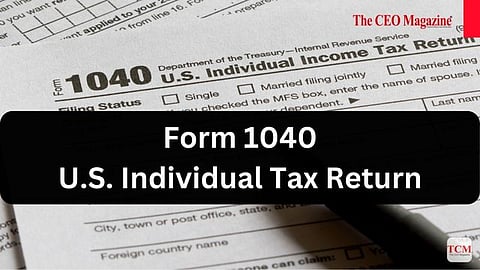
- News
- Women
- Magazine
- IndustryIndustry
- InsightsInsights
- Success Stories
- PublishPublish
- ContactContact
- Media KitMedia Kit

Form 1040
U.S. Individual Tax Return
Tax season can often be a confusing time, with numerous forms and regulations to navigate. One of the most crucial documents in this process is Form 1040, the U.S. Individual Tax Return. In this guide, we'll delve into the definition, types, usage, and everything you need to know about Form 1040 to successfully file your taxes.
Form 1040 is the standard form provided by the Internal Revenue Service (IRS) for individual taxpayers to report their annual income and calculate their tax liability or refund. Essentially, it's the document where you declare your income to the IRS, determining whether you owe additional taxes or are eligible for a refund.
Filing Form 1040 is mandatory for individuals whose income surpasses certain thresholds. These thresholds vary based on filing status and age.
For example, for the tax year 2023, single filers with a gross income exceeding $13,850 were required to file, while for 2024, this threshold increased to $14,600. Similar adjustments apply to other filing statuses like married filing jointly or head of household.
Dependents, including children, might also need to file depending on their income and dependency status. Various situations, such as owing special taxes or having self-employment earnings over $400, may necessitate filing Form 1040, regardless of income level.
Form 1040 is available on the IRS website and can be filed either through mail or electronically.
Taxpayers are required to provide personal information such as name, address, Social Security number, and details about dependents. The form also includes sections for reporting different types of income, such as wages, salary, interest, capital gains, and pensions.
Depending on individual circumstances, taxpayers may need to attach additional schedules to their Form 1040. These schedules help in reporting various types of income, deductions, and credits, ensuring accurate tax calculations.
While the standard Form 1040 caters to the needs of most taxpayers, certain situations call for the utilisation of different variants. For nonresident aliens engaged in U.S. trade or business activities, Form 1040-NR serves as the appropriate form. This variant ensures compliance with tax obligations specific to this demographic.
Additionally, taxpayers estimating and paying quarterly taxes are required to use Form 1040-ES. It facilitates the accurate calculation and timely submission of estimated tax payments throughout the year.
In cases where amendments to previously filed tax returns are necessary, taxpayers can utilise Form 1040-X. This form allows for the correction of errors or updates to information provided in earlier filings.
Moreover, taxpayers aged 65 years or older benefit from Form 1040-SR, which is tailored to address their unique tax considerations. This specialised form provides a streamlined approach to tax filing, accommodating the needs of older taxpayers with clarity and efficiency.
The standard deduction varies depending on filing status and age. For instance, for the tax year 2023, single filers were eligible for a standard deduction of $13,850, while those married filing jointly could claim $27,700. Additional deductions apply to individuals aged 65 or older or blind.
Extra schedules work together with Form 1040 to explore different parts of a person's financial situation. Schedules like A, B, C, and D focus on specific things like listing deductions, showing interest, reporting business earnings, and documenting gains from selling assets.
There are also other schedules for special situations, like farming income, taxes for household employees, or claiming earned income credits. These schedules make sure that all aspects of a person's taxes are covered thoroughly.
Form 1040 serves as the primary tax form for U.S. taxpayers to report their annual income and calculate their tax liability or refund. It's a crucial document that provides the IRS with essential financial information necessary for accurate tax assessment.
Navigating the complexities of tax filing can be daunting, but understanding Form 1040 is essential for all U.S. taxpayers.
Whether you're a single individual, a married couple, or a senior citizen, Form 1040 ensures accurate reporting of income and taxes owed, ultimately facilitating compliance with IRS regulations.
By familiarising yourself with the intricacies of Form 1040 and its related schedules, you can navigate tax season with confidence and peace of mind.
Follow us on Google News
